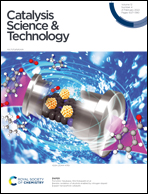Click-based conjugated microporous polymers as efficient heterogeneous photocatalysts for organic transformations†
Abstract
Due to their tunable porous structure and photoelectric properties, conjugated microporous polymers (CMPs) have provided a new platform for visible-light driven photocatalysis. Some synthetic methods like Sonogashira, Suzuki, oxidative coupling and trimerization reactions have been commonly employed to synthesize photocatalytically active CMPs, but the copper promoted azide–alkyne click reaction is not yet fully used. In this study, we describe the design and synthesis of three 1,2,3-triazole-thiophene based CMP (Ta–Th) photocatalysts through the click reaction. Compared with the corresponding thienyl- and bithienyl-bridged Ta–Th-4 and Ta–Th-5, the terthiophene based Ta–Th-6 shows a stronger light-harvesting ability, a narrower optical energy gap, and a better charge separation efficiency for facilitated charge transfer, which make Ta–Th-6 a promising candidate for photoredox reactions. Indeed, Ta–Th-6 presents superior photocatalytic activity in the Ugi multicomponent reaction and α-oxidation of N-substituted tetrahydroisoquinolines. Furthermore, the catalyst exhibits a considerable activity after recycling five times, demonstrating its high stability and excellent reusability.



 Please wait while we load your content...
Please wait while we load your content...